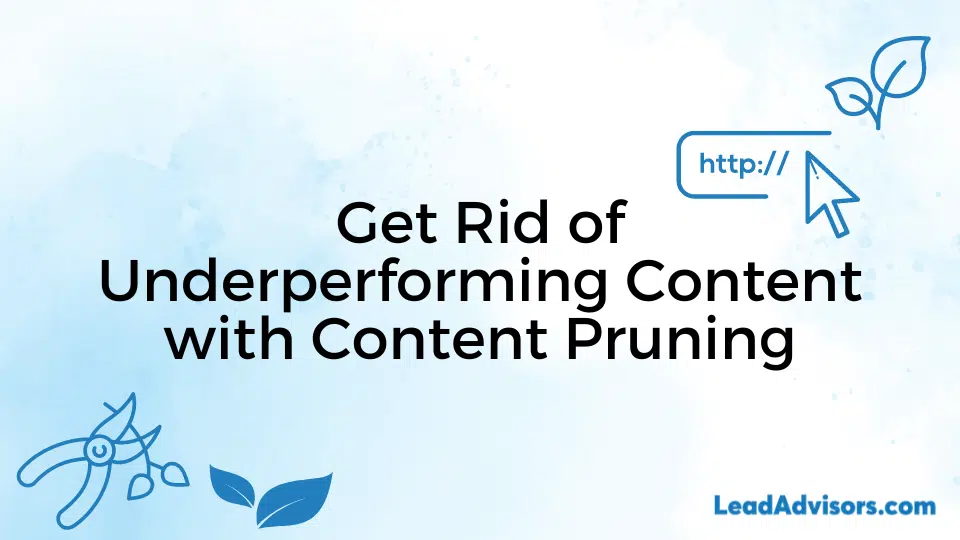If you have tried optimizing your website’s title and tags or using a content hub, but you feel like your SEO strategy is not working, it is time to consider content pruning.
Just as gardeners prune plants to foster healthy growth, website owners must regularly prune their content to ensure a thriving, dynamic site. Doing so lets you focus on delivering high-quality, relevant information that meets your audience’s needs and expectations.
This guide will delve into the benefits of content pruning and provide step-by-step instructions on how to prune your content effectively.
What Is Content Pruning?
Content pruning involves evaluating and removing outdated, underperforming, or irrelevant content from your website. This ensures an active, easily managed, clean, and informative site ranks well in search engines.
A study by SEMrush revealed that 42% of websites that frequently remove old content notice a major improvement in their general performance metrics (like click-through rates and search positions). With careful content management, you can maintain your position as a dynamic and authoritative website.
Why Is It Called “Content Pruning”?
The term “content pruning” is derived from the gardening. In gardening, pruning involves trimming away dead or overgrown branches to encourage healthy growth and improve the plant’s overall structure. Similarly, content pruning involves removing outdated, underperforming, or irrelevant content from a website to enhance its quality and performance.
Like gardeners prune plants to foster a more vibrant and flourishing garden, website owners prune their content to create a more streamlined, valuable, and user-friendly site.
This process helps ensure that the remaining content is high-quality, relevant, and capable of driving better engagement and higher search engine rankings. The metaphor of pruning highlights the importance of regular maintenance and careful selection to promote growth and vitality, whether in a garden or on a website.
Benefits of Content Pruning
In the following parts, you will learn the benefits of content pruning that might help your site.
Enhanced User Experience
Content pruning results in a more streamlined, easier-to-consume, and even better visitor experience. It also lowers the bounce rate. With that, there are more happy audience users and lots of engagement.
Improved SEO Performance
Search engines better understand what your site should rank for when you focus on your core content. It is only when pitter-patter content runs amok that removing it helps improve your site’s overall quality/relevance, thereby improving your SEO performance.
Increased Site Speed with Content Pruning
Removing unneeded content will greatly speed up your site’s loading speed. Improving site speed is one important aspect of maintaining the best user experience. Also, increasing speed is very helpful in search engine results since faster sites perform better in search results.
Better Resource Management
Pruning allows you to distribute your resources better. It allows you to stop wasting time on a zillion pages and focus on a handful of high-performing pages instead.
Higher Conversion Rates with Content Pruning
A site’s improved performance can lead to more conversions. This better serves the needs of actual visitors due to this increased focus in all areas.
Those visitors can find the information they need and take the actions they want as an agency. A pruned website leads to increased conversion rates, all things being equal, by moving users more efficiently toward their desired outcome.
How to Identify Content for Pruning
Review performance characteristics systematically to determine which content needs pruning. The following sections will cover the key steps and tools for an effective content analysis.
Extraction of Traffic and Engagement Metrics
First, examine your traffic and engagement stats to identify pages that have significantly underperformed. Start with pages low on traffic and engagement metrics, as these are your biggest pruning contenders.
Evaluating Relevance and Quality of Content
Asses how applicable and great your content is. The first is to pull the plug on outdated or low-quality pieces. Besides, this process should help ensure your website stays a valuable and authoritative resource by ensuring the content is relevant and high-quality.
Using SEO Tools for Content Pruning Analysis
Use SEO tools to collect insights on how well your SEO-optimized content is performing. SEMrush and Conductor are a couple of tools that can help with that.
Consequently, content pruning cannot be done without the use of the best SEO tools for analysis, which provide more granularized and costly actionable recommendations.
Reviewing Backlink Profiles
Take a close look at the backlink profile of your content pages. Pages with few or poor-quality backlinks certainly will not transfer much authority to your site. This analysis can help identify what content needs to be kept or improved when examining backlink profiles.
Find Duplicate or Thin Content
Find and remove thin or duplicate content that doesn’t provide value to your audience. Taking these pages out or combining them will help improve the general quality of your site. One way to keep a robust, authoritative site is to check for duplicate or thin content.
How to Prune Content
Content pruning is an intentional methodology for analyzing and deleting outdated material from your website. Follow these steps to prune your content properly and improve your overall site quality and performance.
Do a Deep-Dive Content Audit
Start with a comprehensive content audit to evaluate the performance of your website’s pages. Use a mixture of tools (e.g., Google Analytics, SEMrush, Conductor) to pull data on traffic, engagement, and SEO metrics. A good content audit tells you exactly what pages not performing well.
Find Underperforming Content
Look for content that has low traffic, high bounce rates, and little to no engagement. This indicates that the content is either not well received by your site’s audience or not contributing to the site’s goals.
Assess Content Operability and Quality
Evaluate every page for relevancy and page quality. Old, duplicate, or thin content is bad for your site’s authority and looks careless to users. This helps identify content that is not relevant and less valuable and keeps your site fresh with current information only.
Refresh or Reuse High-Value Content
Take valuable content and, instead of outright deleting it, update it or even repurpose it to serve you better. Update obsolete data, introduce new knowledge, and align with modern SEO standards. Updated or repurposed content can perform better and have a longer shelf life.
Extricate Useless and Spam Pages
You should remove pages from your site that are no longer useful, or that cannot be fixed in content quality. Use 301 redirects to basically ensure visitors land on the related content they were trying to navigate. Several pages that are not related to this topic and are not of very good quality result in the site’s standard going for a toss.
Monitor and Adjust Regularly
Content pruning is not a one-off. To keep up with the competition, you should measure your site’s performance regularly and be prepared to adapt your content strategy as needed. Implement timely content audits.
Further, make sure your site always looks its best. Regular monitoring and adjustments help maintain a healthy and performing site. However, the above steps to prune content help ensure your website stays relevant, useful, and well-optimized for users and search engines.
Content Pruning Best Practices
Effective content pruning requires following best practices to maximize its benefits. The sections below outline these practices in detail, ensuring your website remains relevant, valuable, and optimized.
Conduct Regular Content Audits
Perform regular content audits to keep your site’s content up-to-date and relevant. Use tools like Google Analytics and SEMrush to evaluate each page’s performance. Regular content audits help identify which pieces are underperforming and need attention.
Focus on User Experience
Always prioritize user experience when pruning content. Ensure the remaining content is easy to navigate, informative, and engaging. Altogether, a positive user experience can lead to higher engagement and lower bounce rates, ultimately benefiting your site’s performance.
Update and Repurpose Valuable Content
Instead of just removing content, consider updating or repurposing valuable pieces. Refresh outdated information, optimize for current SEO best practices, and repurpose content into different formats, such as infographics or videos.
Updating and repurposing valuable content can extend its lifespan and improve its performance.
Use Data-Driven Decisions
Base your pruning decisions on data rather than assumptions. Analyze traffic, engagement, and SEO metrics to determine which content needs to be pruned. Also, data-driven decisions ensure that your actions are backed by concrete evidence, leading to more effective results.
Implement 301 Redirects for Removed Content
When removing content, use 301 redirects to guide users to related pages. This ensures they still find valuable information and helps maintain your site’s SEO value. Implementing 301 redirects for removed content prevents broken links and preserves link equity.
Monitor Performance Post-Pruning
After pruning, continuously monitor your content’s performance to ensure the changes have a positive impact. Use analytics tools to track improvements in traffic, engagement, and SEO rankings. Monitoring performance post-pruning allows you to adjust your strategy as needed.
Maintain a Content Calendar for Content Pruning
Keep a content calendar to schedule regular audits, updates, and new content creation. This helps you stay organized and ensures your site remains fresh and relevant. Maintaining a content calendar promotes consistent content management practices.
Content Pruning Tools & Resources
This list of content pruning tools will help you make data-driven decisions and better manage your website content. The subsequent areas present a number of the simplest selections available.
Google Analytics
It is only possible to monitor your SEO performance by monitoring overall traffic and engagement metrics using Google Analytics. Google Analytics gives information about how users are navigating through your website and which pages perform worst. It is one of the core software for content pruning.
SEMrush
SEMrush boasts a full suite of top-rate SEO analysis tools perfect for content audits. Indeed, it pinpoints content areas you need to optimize for and even gives you data about traffic on your website, keywords, and backlinks for analysis. SEMrush for deep content analysis.
Conductor
Conductor empowers you with deep data around content performance and SEO health. Generally, it provides input on how your content is working and where it needs to be improved. Conductor is a great tool for optimizing your content strategy.
Ahrefs
Ahrefs is another popular all-in-one SEO tool that helps with content audits. Detailed backlinks, keyword rankings, and content performance can be focused on by Ahrefs. Moreover, they help you find which site content has contributed the most to your site authority.
Screaming Frog SEO Spider
A website crawler that identifies common SEO problems such as broken links and duplicate content is Screaming Frog SEO Spider. It is an excellent tool for assessing the health of your website content. Additonally, with content pruning, you can delete low-quality pages with technical problems found by the Screaming Frog SEO Spider.
ContentKing
ContentKing provides real-time content monitoring and auditing, which alerts you of SEO issues and content changes. Long story short, it helps keep your content optimized. For ongoing content management and optimization, ContentKing performs highly useful and actionable.
Difference Between Content Pruning and Content Cannibalization
Content pruning and content cannibalization are critical yet distinct strategies for maintaining a high-performing website. Content pruning involves removing outdated or underperforming content to enhance the overall quality and relevance of your site. This leads to improved user experience and SEO performance.
On the other hand, content cannibalization occurs when multiple pages target the same keyword, causing internal competition that confuses search engines and lowers rankings. Addressing cannibalization involves consolidating similar content or differentiating page focuses. By regularly auditing your content and analyzing keyword strategies, you can effectively manage both issues to optimize your website’s performance and search engine visibility.
Difference Between Content Pruning and Content Syndication
Content pruning and content syndication are distinct content management strategies with different objectives. Likewise, content pruning focuses on improving site quality by removing outdated or underperforming content, enhancing user experience, SEO performance, and site speed.
In contrast, content syndication aims to expand your content’s reach by republishing it on third-party platforms, driving more traffic, and increasing brand awareness.
Pruning involves regular audits to update or delete low-value content, while syndication involves sharing content with other websites to attract a broader audience. Implementing both strategies can help maintain a high-performing website and maximize content visibility and impact.
Frequently Asked Questions
How often should I prune my website content?
Will pruning content hurt my SEO rankings?
Should I delete old content or update it?
What happens if I don’t prune my website?
Do I need SEO tools for content pruning?
Conclusion
For website owners, cleaning your website is the perfect way to keep your audience’s interests and attention.
Your website should work for your business. Regularly gutting the underperforming content will deliver the performance needed to ensure your site remains a valuable resource for your target audience. From now on, use content pruning as a re-occurring process.


















